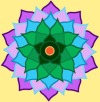Udaipur, Thursday, 27 January 2000
Udaipur is known for its miniature painting. They are small but what is more relevant are the miniature details in the paintings and the exquisite craftsmanship of the painters. Traditionally, paintings are copied from older originals with no copyright problems. The painter acknowledges the original painter and purposely adds an item to make it clear that he does not want to cheat. Amongst connoisseurs the original would be known, who owns it and even some of the important replicas.
On the ground floor of the Udaipur palace, is India’s most famous school of miniature painting. When I visited the school, the students practised copying pictures of selected painters under the guidance of their teachers. I was informed about other subjects such as paint and substrate preparation, brush making and the sealing of the finished painting.

Painting is taught as an apprenticeship, with a focus on technicality and skill. The artisan’s work is observed and evaluated by the guild of leading artists (and the merchants), who would, if found worthy, invite the aspiring painter into their group.
The students looked quite young, however, I won’t try to guess their age. Indians appear to me younger than they really are. No one wore spectacles. Some of their work as on display for other students to see, not for sale, even I tried. The teacher recommended a merchant and gave me the address.
§
Later this afternoon, during one of my daily explorations of the town, I passed by the mentioned gallery for miniature paintings. As I was to discover, it had been the owner who had invited me to enter and over a cup of very good chai he educated me about miniature paintings.
Since I painted, I could ask specific questions which he answered happily to much detail, noticeably enjoying the opportunity to demonstrate his knowledge. We both delighted in our tea party and after some considerable time, more than an hour, he gave me a tour of the exhibition. Fascinating.
The paintings were not overly expensive and one painting, in particular, caught my interest, I could say desire? Its size was about 25 by 8 centimetres and its price about $400 (in the year 2000). Not unaffordable, however, since it was still early days on our journey, I did not spend the money, even I was extremely tempted.
§
At the end of the journey, I wished, I would have bought it; still, I will survive without it. What reminds me of it, is the impression I wrote after I had left the gallery, sitting in the palace gardens. It was a painting of a harem’s drawing-room where several women occupied themselves with dressing and grooming and all sorts of handicraft. What drew my particular attention was the figure of one woman sitting separately from the group near a window, looking outside, forlorn, apparently doing nothing in what one could call a meditative pose.
After having arrived back to the quietness in my hotelroom, I felt inspired to write a poem about this woman.
Her
What draws my attention is all.
With a crystal brushstroke of morning dew,
Woven from Aphrodite’s illusions,
Like a lover’s caress with thousand butterfly hands.
A gossamer gown clings to her body
The gold embroidered edge, a slender snake embraces her
Her frangipani skin emits moonstone lustre.
Her raven gloss hair fondles her shoulders.
She kneels, her thighs apart.
Absorbed by innermost delight, her eyes fathom infinity.
An airless sigh parted her lips, dark crimsoned with passion.
An endless quiver, she steps beyond what holds her human.
A moment set in time, a diamond holding ecstasy.
Retained feelings blush the fragile vessel.
Revealed with silent resonance between hearts.
Ω
written: Udaipur, Thursday, 27 January 2000
published: 21 November 2019

Read the next story: Jag Mandir the Garden Palace
Indian Journey Log
top of page
